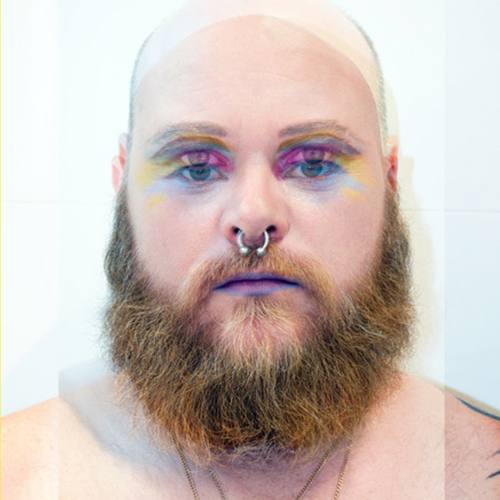As you move through the day reflect on the way you inhabit your body and what aspects of your behaviour seem particularly gendered to you. Does your performance of your gender change in different contexts? Can you discern where you have picked up gendered mannerisms and behaviour from?
“Mapping my gender in a day!”
Fig. 1. Make-Up for Beginners: Brigitte Bardot to David Bowie. [1]
In this essay I will explore three daily gender performative acts. The walk, the hand shake and the shave. These hegemonic social customs are regulated and inscribed by social institutions with different practises depending on the gender you are assigned.[2]
Simone De Beauvoir states that “one is not born, but rather becomes.”[3] Butler expands on this theory and posits that the process of becoming your assigned gender, occurs through a strictly regulated sequence of repeated acts that imprint upon and formulate the gendered body.[4] This starts from birth, a child is assigned a gender based on sex, from that point the systemic genderisation begins.
Reflecting on my own positionality within a heteronormative society is vastly different today, as from sixteen years ago. Today I am an able bodied white male, but as I dress in my gender for the day, it becomes apparent from my markings, surgical scars and mannerisms that I am not “born” male. My body is an anthropological dig of my histories, markings, makings and imprints.[5] A day in mapping my gender becomes a day mapping several distinct identities: Male, Female and other! All of these histories intersecting in one body.
The Walk
“He said walk like a man, Talk like a man, Walk like a man my son…” [6]
My father never taught me to walk like a man. I taught myself over the years of my transition in order to normalise and realign my traits from female to male, and to inhabit my self-fashioned manhood through signifiers. My “male” walk was taught to me by a friend who described it as walking with weights in your groan. Men spread their legs, he advised, to take up space. I occupy a relatively unique position, in that my histories influence my perspective and my subjectivity. As I walk in my embodied male gender the lay of the land opens up for me in specific ways that allow me to take up more space, which it would not have done for my female gendered embodiment of sixteen years ago. This experience is supported by trans* writer James St. James, “I was being treated better by everyday America because people were reading me as a young, white, straight (?!) male. And I recognized many new privileges that came my way because of it.” [7] In place and space I perform male and are therefore defined and privileged by my manhood.
The hand shake
“I look like a woman and feel like a man!” [8]
In my previous subjectivity as “woman” I was never presented with a need to negotiate a handshake,. not even when I was presenting as a female masculine body in a formal space. However as soon as I started to present as “male” I was confronted by a handshake at every greeting. This is evident when walking into a room on a daily basis. This custom changes due to the formality and context of the meeting. If I am accompanied by my male partner whilst in corporate attire, and bump into a colleague, the equalizing/acknowledging handshake is replaced with an informal nod and hello, casting me as “other”, an outsider, the polluted body. [9] After transitioning my hand shake was criticised for a lack of power, not manly enough, interview techniques taught me to make eye contact and give a firm “manly” handshake.
The shave
“Feeling like a woman, looking like a man.” [10]
 Fig 2: Woman Shaving Her Leg by George Segal. [11]
Fig 2: Woman Shaving Her Leg by George Segal. [11]
As a woman who played sports I shaved my legs and arm pits every couple of days, these customs were removed as I transitioned to male. I no longer shave my legs or my arm pits, but as a man the razor has moved from the legs and underarms to the face.
Fig. 3. “A man who saves his face, probably shaves his vagina too.” Meme. [12]
With the advent of the hipster movement the beard has become a new fad of male signification. The razor is only used to tidy up your neck and to create a clear line enunciating your status as fashionable, civilised, clean. The hipster fashion has left behind those men who aren’t capable of growing a beard, thus creating a power relation between the bearded and the beardless. As evidenced and constantly reproduced in popular culture. See Meme, Fig 3. The changeability of these customs based on fads and fashions exposes male signifiers as being culturally produced. When I was a child I saw the beard, as well as the act of face shaving as a major performance of manhood, so for me having a beard is a sign of having attained maleness, a milestone of my transition.
“You Think You’re A Man.” [13]
This essay has explored three key gender performative acts that have varied greatly over my life. “By regularly wearing certain kinds of clothes, walking in certain conventional ways.”[14] I have consciously embodied maleness on a daily basis. The experience of writing this essay has highlighted to me that I inhabit my body in a conscious, rather than unconscious way. Without “performativity” my gender would be vague, my position within society would be unclear.
Footnotes
[1] Unknown Artist, “Make-up for Beginners: Brigitte Bardot to David Bowie”, in Vested Interests: Cross-Dressing and Cultural Anxiety, Marjorie B. Garber (London: Penguin Books, 1992), 162.
[2] Alison Stone, An Introduction To Feminist Philosophy, (Cambridge: Polity, 2007), 61.
[3] Judith Butler, “Sex And Gender In Simone De Beauvoir’s Second Sex,” Yale French Studies, no. 72 (1986):35
[4] Judith Butler, Gender trouble: feminism and the subversion of identity, (New York: Routledge, 1990), 44.
[5] Michael Ryan, and Musiol Hanna, Cultural Studies. Malden, (MA: Blackwell Pub, 2008), 207.
[6] Lyrics. Song performed by Devine. Bob Gaudio, and Bob Crewe. Walk Like A Man (Remix). (London: Proto Records, 1985) Compact Disc.
[7] James St. James, “These 25 Examples Of Male Privilege From A Trans Guy’S Perspective Really Prove The Point.” Everyday Feminism, accessed 1 August 2015, http://everydayfeminism.com/2015/05/male-privilege-trans-men/
[8] Lyrics. Song performed by Cheery 2000. R. Lafferty and A. Rantzen, Feel Like A Man. (Sydney: Ear Pimp Music, 2003), Compact Disc.
[9] Michael Ryan, and Musiol Hanna, Cultural Studies. Malden, (MA: Blackwell Pub, 2008), 208.
[10] Lyrics. Song performed by Grace Jones. Grace Jones, Walking in the Rain. (England: Island Records, 1979), Vinyl Record.
[11] George Segal, Woman Shaving Her Leg, 1968, Plaster, metal, porcelain, and Masonite.
[12] “A Man Who Shaves His Beard Probably Shaves His Vagina…” memegenerator.net, accessed 1 August 2015, http://memegenerator.net/instance/55592912.
[13] Lyrics performed by Devine. Deane, Geoff. You Think You’re A Man. London: Proto Records, 2015. Vinyl.
[14] Alison Stone, An Introduction To Feminist Philosophy, (Cambridge: Polity, 2007), 61.
BIBLIOGRAPHY
- Burgett, Bruce, and Glenn Hendler. Keywords For American Cultural Studies. New York: New York University Press, 2007.
- Butler, Judith. Gender trouble: feminism and the subversion of identity. New York: Routledge, 1990.
- Butler, Judith. “Sex And Gender In Simone De Beauvoir’s Second Sex.” Yale French Studies, no. 72 (1989):35 – 49.
- Deane, Geoff. You Think You’re A Man. London: Proto Records, 2015. Vinyl.
- St. James, James. “These 25 Examples of Male Privilege from a Trans Guy’s Perspective Really Prove The Point.” Everyday Feminism, accessed 1 August 2015. http://everydayfeminism.com/2015/05/male-privilege-trans-men/.
- Gaudio, Bob, and Crewe, Bob. Walk Like A Man (Remix). London: Proto Records, 1985. Compact Disc.
- Jones, Grace. Walking in the Rain. England: Island Records, 1979, Vinyl Record.
- Lafferty, R, and Rantzen, A. Feel Like A Man. Sydney: Ear Pimp Music, 2003. Compact Disc.
- Memegenerator.net. “A Man Who Shaves His Beard Probably Shaves His Vagina…” accessed 1 August 2015, http://memegenerator.net/instance/55592912
- Ryan, Michael, and Hanna Musiol. Cultural Studies, 205 – 216. Malden, MA: Blackwell Pub, 2008.
- Segal, George. 1968. Woman Shaving Her Leg. Plaster, metal, porcelain, and Masonite. Chicago: Museum of Contemporary Art.
- Stone, Alison. An Introduction To Feminist Philosophy, 61 – 72. Cambridge: Polity, 2007.
- Artist Unknown, “Make-up for Beginners: Brigitte Bardot to David Bowie.”, In Vested Interests: Cross-Dressing and Cultural Anxiety, Marjorie B. Garber, 162. London: Penguin Books, 1992.




